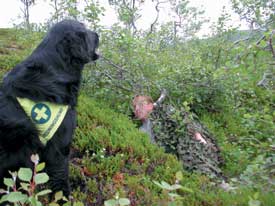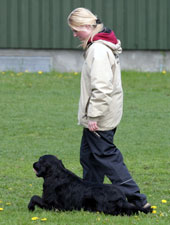
Kira (age 4 months) heeling
What were the origins of your work with animals?
Morten: I got my first dog at the age of 16, and went into obedience, working dog trials, and search and rescue (SAR) work very early. When I was 18, my dog was already certified as a search and rescue dog and had competed in the highest obedience and working dog classes. I was very lucky with my first dog. He was a great dog and I have never owned another like him. Together we won a lot, although I really didn't know what I was doing early on. For the first six years I trained dogs all the time—it's amazing that I got through school.
Cecilie: At the age of 12, I got into horses and used to ride a neighbor's Doel (one of three Norwegian breeds). He was a pleasant and gentle stallion. When I was 16 my family got a dog, but Ceca soon became my dog. We started off working in obedience and agility, and also learned some tricks that we used to entertain the audience during intermissions at large shows.
One summer I had an instructor who also trained search and rescue, so when I moved to Trondheim to study, I got into search and rescue work, too. Trondheim is where Morten and I first met. After two years of training, Ceca was certified as a SAR dog, and a year later she was also certified to search avalanches. During those years I also started competing in working dog trials.
Five years ago I got a "rescue horse" and got back into horse training. The horse was a stallion Doel, like my first horse, but not at all pleasant and gentle. He was actually quite ill-tempered! Thanks to my new knowledge and training, I was able to train him to be pleasant to me and manageable with others.
When I look back, I feel like my introductions to different dog sports and horse training happened by chance. My genuine interest in working with animals, and training in particular, has led to our current household of three dogs, two horses, and two cats, and to competing with both my dog and my horses. Of course, this interest has also left me with no spare time!

Tia and Cecilie tracking
How did you first encounter clicker training?
Morten: We have always trained more "positively" than most other dog handlers around us. We both studied psychology and were familiar with the principles of operant conditioning by the early ‘90s, so I guess we were predisposed. When we read A Dog and a Dolphin (Getting Started: Clicker Training for Dogs) and Don't Shoot the Dog in 1995, all the pieces just came together. And when we started using clicker training on our own dogs, there was no going back.
Though we had learned the basic principles of clicker training from Karen Pryor, no one had really taught us how to use clicker training for obedience, search and rescue, or working dog training. We had to figure that out for ourselves, and that was the most interesting part of those early years—especially since everyone told us that it couldn't be done.
Morten, how did you evolve into working with search and rescue dogs?
Morten: SAR training was actually where I started my dog training career, but I got into it by accident really. When I was walking my dog, I bumped into someone who was into SAR training so I joined in, and that was it. I have always enjoyed outdoor life and my dog was perfect for SAR training; we received lots of reinforcement as soon as we got started. In 1995, I met Cecilie at SAR training—that was a nice bonus, too! Coincidentally, our dogs happened to have the same father.
Cecilie, as a doctor, how do your interests in psychology and clicker training relate to each other?

Kiro indicating where a human
is buried in masses of snow
Cecilie: I feel that my knowledge of psychology gives me strength in both my own training and in teaching others. Since clicker training has such a great scientific base in psychology, I trust the method to the fullest extent. I love that the training I use has its base in a scientifically proven field—it's not just someone's opinion or "know-how." No matter what we do practically in clicker training, we can find the theoretical background in the field of psychology. "Treat every time you click" translates into "Learning occurs most rapidly in cases where relation between a conditioned stimulus and an unconditioned stimulus is perfect, ergo in situations where an unconditioned stimulus always follows a conditioned stimulus." (Svartdal, F. and Flaten, M.A. Læringspsykologi. Oslo: AdNotam Gyldendal, 1998.)
The beauty is that you can use clicker training without any knowledge of psychology whatsoever. The practical application is simple and straightforward. As long as you are aware that there is a science behind the method, you can ignore the science and still use clicker training with excellent results. Those of us with special interest can choose to immerse ourselves in the psychology and science.
What is the current status of clicker training in Scandinavia?

Kiro barking to indicate
where he has found a human
Cecilie: Actually, we think that the percentage of dog owners in Scandinavia that use clicker training is higher than anywhere else in the world, including in the US. Norway and Sweden, especially, have come very far, and in Denmark and Finland a great deal is going to happen in the next few years.
More than 40,000 copies of our book, Clickertraining—the Four Secrets of Becoming a Supertrainer, have been printed in Scandinavia since 2001, our magazine Canis has about 10,000 subscribers, and our websites are visited by more than 100,000 unique visitors every month. Scandinavian dog owners basically can't avoid hearing about clicker training. Of course, we are also struggling with the "clicker training versus clicker using" problem.
The next challenge is to teach people how to use the technology most efficiently, and we are working on that. Our Canis dog training school is a franchise chain established in 18 cities in Scandinavia so far. We offer all kinds of dog training classes—100% based on clicker training.
You both enjoy competing—tell us about your recent successes.

Tia and Cecilie training
“crawling,” an obedience
exercise in working dog
trials in Norway and Sweden
Morten: My old dog died a year ago, so I haven't competed very much over the last three years. I have a new puppy right now, and hopefully will start competing again next summer.
Cecilie: I'm doing well with my dog at the moment. Tia qualified for the National Working Dog Championship for the second time this summer (only the 15 best working dogs in Norway qualify). That competition has always been the big goal of the season for us. It seems like Tia will qualify next year, too, but that will probably be her last season competing, as she is now 9 years old. Tia earned her title as a Working Dog Champion this fall as well.
We have spent a lot of time teaching these last years, so we can't compete as much as we did before. But we really enjoy it when our students are doing well—and they are!
How do you feel about joining the ClickerExpo faculty?
Morten: We are really looking forward to joining all of the great people on the ClickerExpo faculty. The faculty members are experts in their fields, and we will aspire to lead Sessions and Learning Labs that will live up to ClickerExpo's reputation.



Post new comment